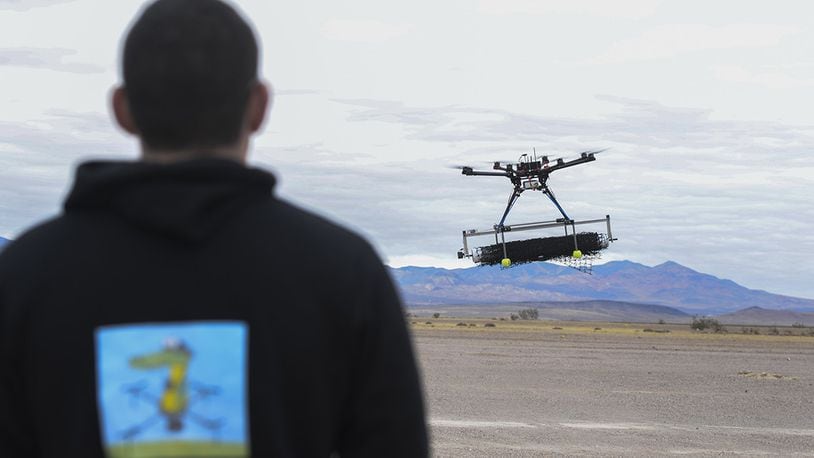This year’s challenge is called the “Precision Remote Resupply” and is based on resupplying combat troops deployed from a forward operating base. The challenge requires teams to develop solutions to remotely deliver 50 pounds of supplies, 30 miles away, to an area not larger than 400 square feet with minimal manpower to operate and maintain the equipment … all with a budget of less than $50,000.
“I think they want to throw you into the fire,” said Timothy Janczewski, test lead for Team Wright-Patterson Air Force Base. “They want you to experience something that gets you out of your comfort zone and going from working in a laboratory environment where it’s a research focus all the time to more of a demonstration environment where we’re developing something that has to complete a task. So, I am very happy that I have an experience like this that is so different from my day-to-day job.”
Teams from Wright-Patterson, Eglin, Hanscom and Kirtland Air Forces Bases are scheduled to compete for bragging rights as they pit their solutions against yet-undisclosed challenges designed to simulate the forward operating environment. Teams are provided only the basic challenge information and work completely independently from other teams to keep the realm of solutions as wide as possible, said Capt. Alec Rasmussen, 2017 AFRL Commander’s Challenge deputy project officer.
“I am excited to see each of the teams demonstrate their solution,” Rasmussen said. “Each team has pursued a unique solution, so there is no overlap in ideas, other than all of them are dropping ‘something.’ What that ‘something’ is varies, and what carries that ‘something’ is just as diverse.”
What has remained constant for the teams is the process of going from pure concept to a tangible product.
“It definitely lives up to its name as being challenging,” said 1st Lt. Anthony Callaham of Kirtland Air Force Base’s team “The Best Drones (TBD).” “It’s been mostly a learning experience.”
Callaham said his team had to decide what kind of vehicle to use, figure out how to put it together, learn how to make some functions autonomous while keeping control of others, all while integrating the various components to work together and, of course, test the solution.
“In creating this project, we found there’s a lot of challenges to it, especially because none of us really have a background in autonomous control or airplanes in general,” Callaham said. “So, we’ve had to learn a lot about the actual systems that go into them and make a lot of engineering decisions to make this system work.”
Teams consist of six to eight junior personnel from diverse educational and cultural backgrounds across Air Force Materiel Command. While some are engineers, others have acquisition or other backgrounds and the challenge allows team members to expand their knowledge of what it takes to get a product from concept to mission ready, said Rasmussen.
“Nothing is as simple as it seems [but also], things don’t have to be any more difficult than you make them,” said Christopher Perez of Team Hanscom. “I’ve done a ton of research into aerodynamics – what makes something fly, why is a good design a good design – and then back that up with some math. Maybe do a little Matlab or a computer aided design and then some airflow analysis. So, it’s been really cool being able to get into some of those programs that I never would have experienced on the program side of the house.”
The challenge, now in its 10th iteration, is designed to stress the teams in order turn the energy and bright ideas of the junior workforce into workable solutions, with the best concepts possibly finding their way into new or existing Air Force projects.
“This is really an opportunity for [the teams] to learn and grow,” AFRL Commander Maj. Gen. Cooley said at the challenge’s kick off last August. “It’s also an opportunity, as we have seen in prior Commander’s Challenges, to actually do something that matters. We have several examples from past Commander’s Challenges that have actually been deployed and have gone on to become solution sets for some of these hard problems.”
Whether or not the Air Force will obtain a new capability founded in the challenge is yet to be seen, but the lessons of the competition are already being recognized.
“I would say for our team, one of our biggest advantages is our diversity – the fact that we’re not all engineers and we’re not all program managers,” said Skipper Chappelka, a contract specialist with Team Dependables from Eglin Air Force Base. “We have a wide array of people with different skill sets that they bring to the team to really balance this out, and a lot of knowledge and experience when it comes to a lot of different aspects.”
AFRL conducts three challenges a year: the Commander’s Challenge; the Military Academy Challenge, vying teams from the Navy, Army and Air Force service academies; and the University Challenge, a competition between 10 selected universities.
About the Author
